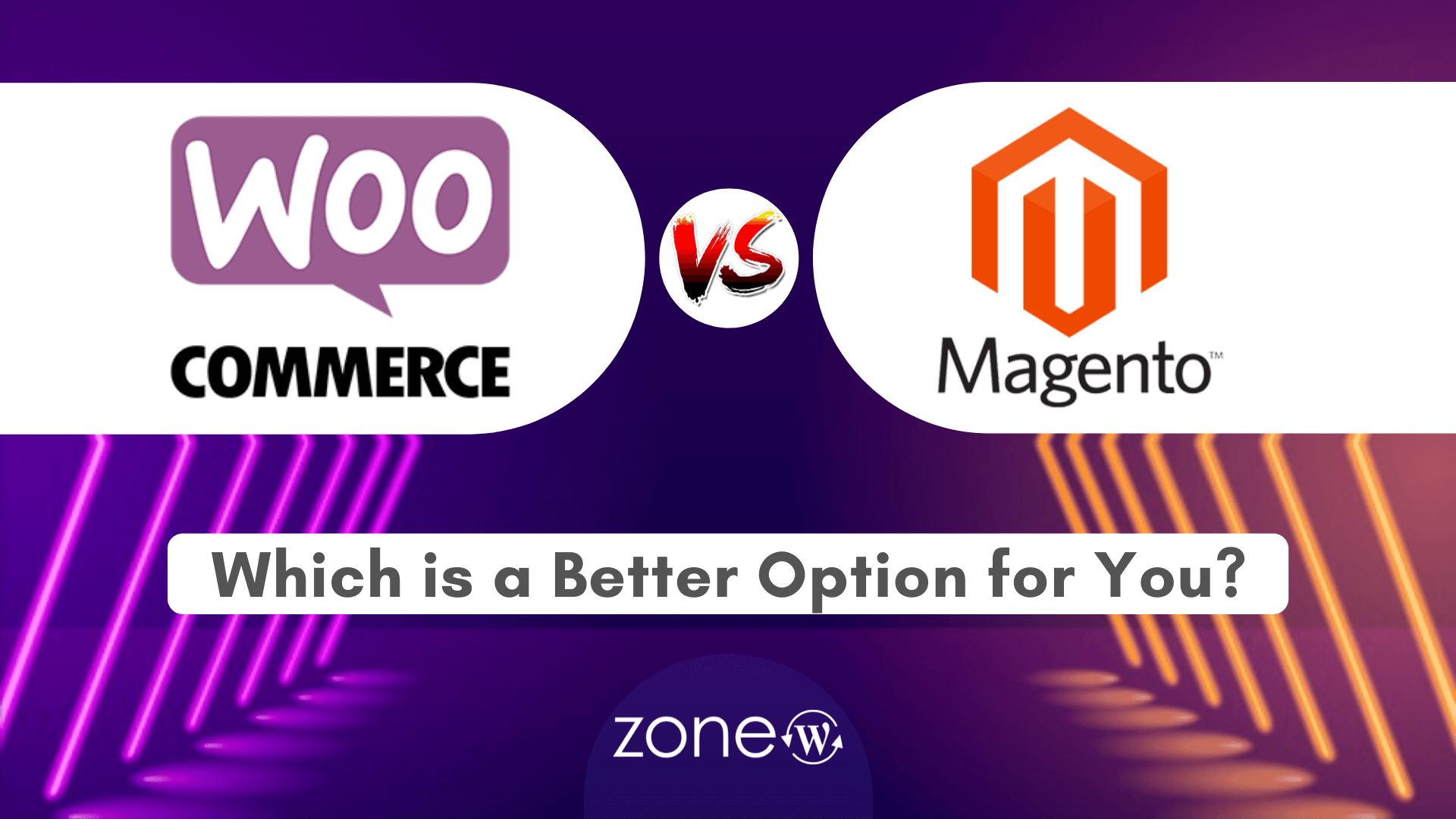Launching your online business website is quite an experience, It’s ineffable. But, you need to take care of a lot of areas from the very first day. Choosing the right design, product upload, traffic management, customer data collection, orders, service requests, and more.
If you want to scale your business, you can’t rely on a tenuous e-commerce platform. Instead, you need an appropriate platform.
In this blog, we will be exploring two of the most popular e-commerce platforms i.e. WooCommerce and Magento. And, we’ll compare both of these based on various factors like features, prices, ease of use, etc.
In the end, you will have a clear understanding of which one will be the right platform for your e-commerce website.
WooCommerce

WooCommerce is an open-source WordPress plugin developed by the Automattic team. Looking to start your online store on WooCommerce? Start by installing WordPress first. And, later you can go for installing the WooCommerce plugin.
It doesn’t matter whether you are a big online business or small business, WooCommerce is simple to operate for everyone.
WooCommerce is one of the most used e-commerce solutions. It powers 489,306 websites and counting, which is a 29.11% market share of overall online stores according to Datanyze.
Magento

Magento development is another way tailored to e-commerce websites. It was released back in 2008, by development teams at Magento, Inc.
It is an open-source platform as well. That means web developers can implement core files and extend their features by adding new plug-in modules. Both of these platforms have a great community base that means you can easily get support if you face any issue.
Coming back to Magento, It is a bit challenging to learn. It is suitable for small to large enterprises.
According to the Datanyze report, Magento has a 4.13% market share of online stores. Which is relatively low compared to WooCommerce.
Before going into the comparison, first, you should know the differences between Magento Open-source and Magento Commerce.
Magento Open-source is the free version, just like WordPress.org, that requires to be downloaded, customized and self-hosted.
Magento Commerce is the premium version of the Magento open-source. It comes with many advanced features not limited to professional reporting, analysis dashboards, integrated drag-and-drop builder, dedicated cloud-hosting, smart support and more.
In the following sections, we will compare the open-source platforms of both WooCommerce and Magento in more detail.
Hosting Comparison

WooCommerce is a lightweight framework plugin that requires WordPress to be installed on the server first. Because it’s a small plugin and requires very little disk space.
However, a cheaper shared hosting package may be good enough for the smooth running of the online store.
Magento’s complexity requires powerful dedicated servers for smooth performance.
The choice of any ordinary hosting provider would result in slow performance of the website and unhappy customers.
Want to learn the things that can help you choose the best hosting provider? Then check out this blog, Points to Consider While Choosing the Best WordPress Hosting Service Provider
Ease of Use

WooCommerce comes with an intuitive design and navigation that makes it very easy to use. Navigating through the WooCommerce dashboard is simple and fast. Also, order management and product management is simple as compared to Magento.
Whether you’re a newcomer or a skilled developer, WooCommerce is a very user-friendly plugin for everyone. Most of the users love the WooCommerce platform because it is faster to set up and requires less technical skills.
On the other hand, Magento requires technical skills and time-consuming as well. It comes with an advanced setup process that’s complicated for new users. Because it focuses more on developers.
The steep learning curve may be demanding. but if you’re able to get on with it, it’s sure to pay off in the future.
Plugins and Extensions

Because WooCommerce is running on top of WordPress. It gives you the option to choose from a collection of over 60,000 free plugins and thousands of paid plugins. The installation process is also very easy.
You can add forms, social media tools, SEO tools, payment options, image gallery, photo editing, cache, product editing options, security plugins to improve the usability of your website.
Moreover, you can integrate your website with third party services. Such as email marketing, payment gateways, marketing automation, analytics, etc. using plugins.
Magento also has a large number of developers and contributors. The marketplace contains a lot of free and paid plugins to expand the functions of your website. However, sometimes you may need the help of a developer to manage a plugin setup.
There are currently more than 5,600 Magento extensions available in the marketplace. The increased popularity of Magento is because of a wide variety of available built-in features that eliminate the need for additional plugins.
It integrates with third-party extensions to make payments and logistics easier.
Themes

WooCommerce has a large number of free and paid themes at its disposal. Similar themes can be found on WordPress.org and other paid sites such as Themeforest, Mojo Marketplace, etc.
You can easily install themes. But it can take some time to configure them.
Magento also has a large number of free and paid themes available. These themes are ready for launch and can be easily applied without the need for customization. You’ll find these on the Magento marketplace and other paid places like Themeforest etc.
If you are a developer then you can make your Magento themes from scratch.
Scalability

Magento is built for e-commerce scalability. It is perfect for people who have a bigger plan to scale their business in the future. It can handle large traffic with ease as long as your hosting plan can handle it.
To handle such large e-commerce stores, you need to optimize your store for caching, backups, security and more. If you don’t have such expertise you can take the help of any professional or Magento community. Scaling a Magento e-commerce store can increase costs.
WooCommerce stores will face the same challenges that Magento stores face. However, you can keep scaling your WooCommerce store with the same pace and features while keeping the costs low.
You can add caching options to improve your store’s efficiency. Even beginners can apply this. Taking the support of any professional for scaling your business is not that costly as Magento.
Security

Magento is considered to be more secure than WooCommerce. As it is specifically designed for e-commerce platforms. It provides advanced security patches to its users to keep their website safe from the latest security issues.
As it requires fewer plugins, the risk factor is logically low because it reduces the number of security exploits. Moreover, Magento is a highly secure platform with an integrated advanced level cache.
On the other hand, the WordPress CMS on which WooCommerce is designed is a blogging platform originally.
Being one of the most popular platforms, it happens to be a more common target of fraud and hacker attacks than Magento.
You have to rely on the built-in security features and third-party security plugins to protect your website from such security issues.
I’ve created a simple blog that guides you through common WordPress issues and vulnerabilities. And how to secure your website with the best WordPress plugins, please check it out the WordPress Security Issues vs the 10 Best Security Plugins.
Price

WooCommerce is a free plugin, that you can install on top of your WordPress website. However, you will have to pay for the hosting, premium plugins and themes that you use.
By using free plugins and themes, you can reduce these costs. To some point, this can satisfy the requirements.
Magento’s open-source edition is free for anyone to use. You’re just going to pay for the hosting provider. Plus, buying any paid extensions, themes or hiring any experts will increase the cost.
Conclusions
Magento & WooCommerce are both packed with features and can be used to build any kind of e-commerce website. But both have different types of the user base.
If you are looking for a cheaper, easy to use the platform, with lots of free themes and plugins, then WooCommerce is for you. You don’t need to be an expert to handle this. With a very small effort and tech knowledge, you can run a small to medium-size online store efficiently.
If you want to scale your business, keep the future in mind, and the price isn’t a problem for you, then Magento is a perfect choice. There’s no need for a lot of plugins to install. It’s not going to fail you in terms of security & scalability. Moreover, it is a perfect choice for companies at the enterprise level.
Is this helpful? Do share your views!







Leave A Comment